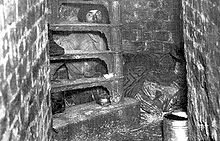Life in the Viennese underground

The life in the Vienna underground began with the establishment of the Vienna sewer end of the 19th century, a refuge for work and the homeless was. This was possible because the sewer system has always been largely accessible, even if this is forbidden to unauthorized persons for safety reasons. Police finally took action against the increasing number of those seeking shelter.
Framework conditions
The Vienna sewer system was completed at a time when Vienna was a rapidly expanding city. The increasing number of jobs attracted a large number of people, but not all of them could actually find work. Social welfare such as unemployment benefits or health insurance did not exist back then, nor were there any homeless shelters or dormitories, and so the number of beggars and other people who had to live on the streets rose rapidly.
As a result, some people quickly recognized a new source of income and accommodation in the Viennese sewer system. However, during heavy rain or thunderstorms, the sewer system can become a deadly trap for the inexperienced. The development of toxic or explosive gas mixtures (gasoline running in, etc.) cannot be ruled out. The “enormous” or even “bestial stench” that is sometimes reported does not exist there. Even where fecal-carrying water flows, it smells more like a damp basement, but it doesn't stink. Nevertheless, staying unsecured in the sewage system is life-threatening.
The image-supported social reports by the Viennese journalists Max Winter and Emil Kläger, which are characterized by particular detail and created through lengthy on-site research, made this problem known to a large part of the Viennese population and met with great interest. In 1905, Max Winter published his social reports from the Vienna Underground in book form under the title “Im unterirdischen Wien”. In 1920, based on Emil Kläger's social reports, the documentary “Night piece from the life of the vagabonds, the derailed and the fallen” appeared in cinemas in Vienna. The newspaper reports as well as the book and the film are among the very first social reports .
Sewerage as a basis for life
The entrances to the sewer system were and are, among other things, housed in so-called “towers” that look like oversized advertising pillars. About Spiral staircases can descend through this in the Vienna "underworld". Around 50 jobless and homeless, presumably even more, spent a large part of each day fishing out objects from the sewage, the so-called “strotting”. These " strotters ", as they were soon called, partly earned their living
- by finding coins and jewelry, which happened rarely, but brought in a lot,
- by fishing out bones and fat for sale at soap factories or
- by taking out all sorts of other useful objects.
Some of these strotters - but also several hundred "ordinary" homeless people - even lived in the sewer system, where they found opportunities to "live" in some corridors, chambers and air shafts.
Hiding places
Probably the best-known accommodation for the homeless and strotters was the "Zwingburg" set up in a dry room under Vienna's Schwarzenbergplatz . The name was due not least to the fact that it could only be reached through a board that had to be placed over a channel and could be pulled in at any time. In this way even the police could be prevented from intruding at short notice. In addition, the "Zwingburg" had several escape routes in the form of side channels and shafts.
Police persecution
Of course, unauthorized persons were not allowed to stay in the sewer system, but the police could not detain strotters and homeless people for too long. The number of strotters and homeless only decreased when the "Canal Brigade" was founded in 1934, which was supposed to crack down not only against criminal gangs, but also against vagabonds . In the meantime, there were also homes for the homeless and dormitories that could offer a reasonable alternative for at least some of the "canal residents", such as the Meldemannstrasse men's dormitory , which became famous because Adolf Hitler spent three years here.
Today's meaning
Apart from the Second World War and the post-war period, when Allied secret agents knew how to use the sewer system of the divided city for themselves, which is also what the film “ The Third Man ” is based on, the sewer system is now due to the numerous social institutions that were built in the social democratically ruled “ Red Vienna” “Began as a place of refuge no longer of any significance. The last newspaper reports about Strotter date from the late 1950s, but the term and the activities associated with it were still known to a large part of the Viennese population.
literature
- Alexander Glück, Marcello La Speranza, Peter Ryborz: Unter Wien - In the footsteps of the Third Man through canals, tombs and casemates . Christoph Links Verlag, Berlin 2001, ISBN 3-86153-238-7 .
